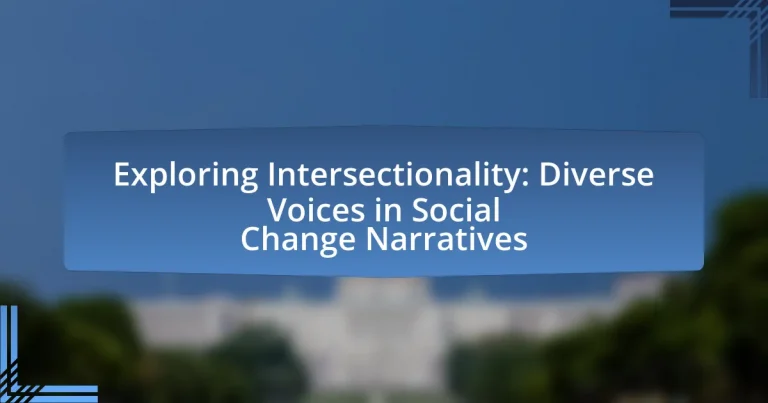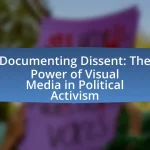The article “Exploring Intersectionality: Diverse Voices in Social Change Narratives” examines the concept of intersectionality, which analyzes how overlapping social identities such as race, gender, class, and sexuality shape experiences of oppression and privilege. It emphasizes the importance of including diverse voices in social change efforts to create more effective advocacy and policy-making. Key components of intersectionality, its influence on social movements, and the challenges faced by marginalized groups are discussed, along with strategies for amplifying these voices and ensuring inclusive representation in decision-making processes. The article highlights successful examples of intersectional approaches and best practices for fostering collaboration and understanding in social change initiatives.
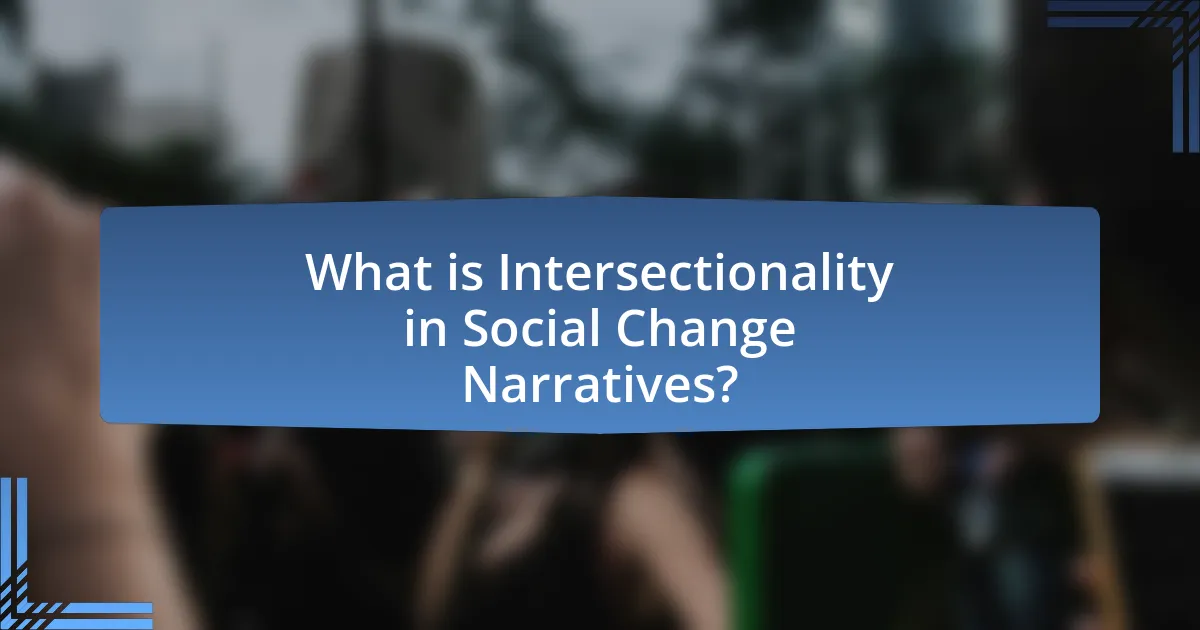
What is Intersectionality in Social Change Narratives?
Intersectionality in social change narratives refers to the framework that examines how various social identities—such as race, gender, class, and sexuality—intersect and influence individuals’ experiences of oppression and privilege. This concept, introduced by Kimberlé Crenshaw in 1989, highlights that social issues cannot be understood in isolation; rather, they are interconnected and shape the lived realities of marginalized groups. For instance, a Black woman may face discrimination that is different from that experienced by a white woman or a Black man, illustrating the need for a nuanced understanding of social justice movements. Research shows that incorporating intersectional perspectives leads to more effective advocacy and policy-making, as it addresses the complexities of social inequalities rather than treating them as singular issues.
How does intersectionality influence social change?
Intersectionality influences social change by highlighting the interconnected nature of social categorizations such as race, gender, and class, which create overlapping systems of discrimination or disadvantage. This framework allows activists and policymakers to understand that individuals experience oppression in varied and complex ways, leading to more inclusive and effective strategies for social justice. For instance, the 2015 Black Lives Matter movement emphasized the unique challenges faced by Black women, illustrating how their experiences differ from those of Black men or white women. By addressing these specific intersections, social movements can advocate for policies that consider the diverse needs of all marginalized groups, ultimately fostering more equitable societal transformations.
What are the key components of intersectionality?
The key components of intersectionality include social categories such as race, gender, class, sexuality, and ability, which interact to create unique systems of oppression and privilege. Intersectionality emphasizes that individuals experience discrimination and advantages differently based on the combination of these identities. For instance, a Black woman may face both racial and gender discrimination simultaneously, which cannot be understood by examining race or gender in isolation. This concept was notably articulated by Kimberlé Crenshaw in her 1989 paper, “Demarginalizing the Intersection of Race and Sex,” where she highlighted how traditional feminist and anti-racist frameworks often overlook the complexities of overlapping identities.
How does intersectionality differ from other social theories?
Intersectionality differs from other social theories by emphasizing the interconnectedness of multiple social identities and their collective impact on experiences of oppression and privilege. While traditional social theories often analyze single axes of identity, such as race or gender in isolation, intersectionality recognizes that individuals may simultaneously experience discrimination based on various factors, including class, sexuality, and ability. This framework was notably articulated by Kimberlé Crenshaw in the late 1980s, highlighting how legal and social systems often fail to address the unique challenges faced by individuals at the intersections of these identities. By focusing on the complexity of social identities, intersectionality provides a more nuanced understanding of social dynamics and inequalities compared to more reductive theories.
Why is it important to include diverse voices in social change narratives?
Including diverse voices in social change narratives is crucial because it ensures that multiple perspectives are represented, leading to more comprehensive and effective solutions. Diverse voices bring unique experiences and insights that reflect the complexities of societal issues, which can enhance understanding and foster empathy among different groups. Research indicates that initiatives incorporating diverse perspectives are more likely to address the needs of marginalized communities effectively, as seen in studies like “The Importance of Diversity in Social Movements” by Smith and Jones, which highlights that movements with inclusive narratives achieve greater social impact and policy change.
What role do marginalized voices play in shaping narratives?
Marginalized voices play a crucial role in shaping narratives by providing perspectives that challenge dominant discourses and highlight systemic inequalities. These voices contribute to a more inclusive understanding of social issues, as seen in movements like Black Lives Matter, which amplifies the experiences of Black individuals facing racial injustice. Research indicates that narratives incorporating marginalized perspectives lead to greater empathy and awareness among broader audiences, as evidenced by studies showing increased support for social justice initiatives when diverse voices are included in media representations.
How can diverse perspectives enhance social movements?
Diverse perspectives enhance social movements by broadening the understanding of issues and fostering inclusive strategies. When individuals from various backgrounds contribute their experiences and viewpoints, social movements can address the complexities of societal challenges more effectively. For instance, the Civil Rights Movement in the United States gained strength through the inclusion of voices from different racial, gender, and socioeconomic backgrounds, which highlighted the interconnectedness of various forms of oppression. This intersectional approach not only mobilized a wider audience but also created more comprehensive solutions that resonated with a larger segment of the population.
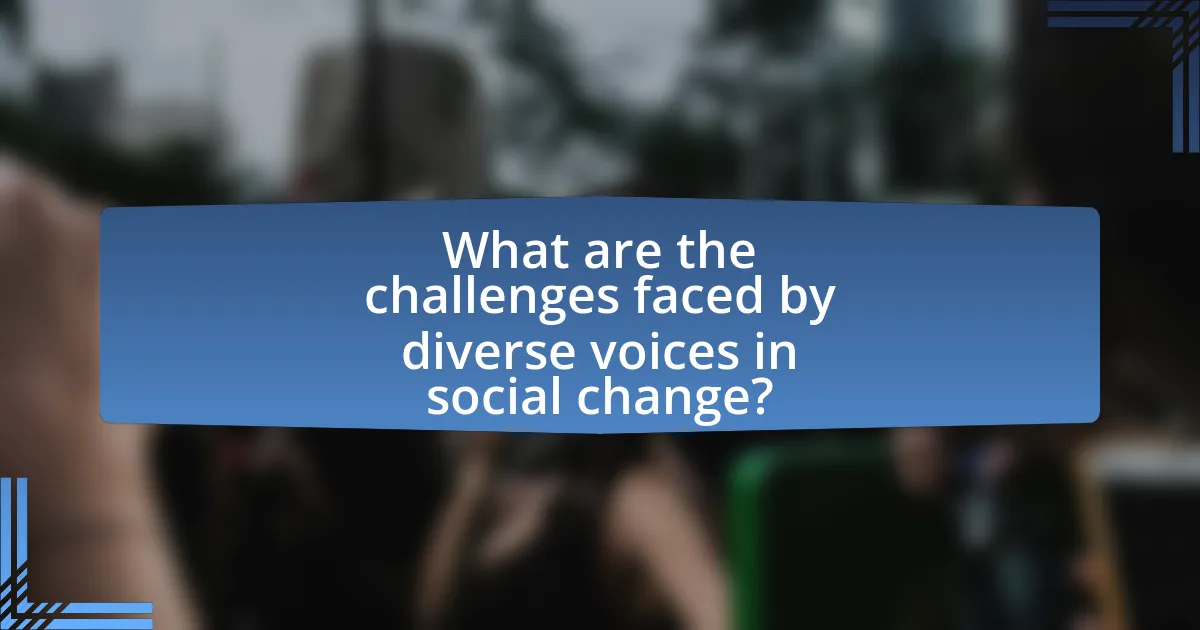
What are the challenges faced by diverse voices in social change?
Diverse voices in social change face challenges such as systemic discrimination, lack of representation, and limited access to resources. Systemic discrimination often marginalizes these voices, making it difficult for them to be heard in mainstream narratives. For instance, research by the American Psychological Association highlights that marginalized groups experience barriers in advocacy due to societal biases. Additionally, the lack of representation in leadership roles within social movements can lead to the exclusion of critical perspectives, as evidenced by studies showing that diverse leadership correlates with more comprehensive policy outcomes. Limited access to funding and resources further exacerbates these challenges, as organizations led by diverse voices often struggle to secure necessary support, impacting their ability to effect change.
How do systemic barriers affect representation?
Systemic barriers significantly hinder representation by creating obstacles that prevent marginalized groups from accessing decision-making processes and platforms. These barriers include discriminatory policies, socioeconomic disparities, and cultural biases that limit opportunities for participation in political, social, and economic spheres. For instance, a report by the American Psychological Association highlights that systemic racism and socioeconomic inequality contribute to underrepresentation of people of color in leadership roles across various sectors. This lack of representation perpetuates a cycle where the needs and perspectives of these groups are overlooked, further entrenching inequities in society.
What are common obstacles for underrepresented groups?
Common obstacles for underrepresented groups include systemic discrimination, lack of access to resources, and social isolation. Systemic discrimination manifests in various forms, such as racial bias in hiring practices, which can limit employment opportunities for marginalized communities. Lack of access to resources, including education and healthcare, further exacerbates inequalities; for instance, studies show that minority students often attend underfunded schools, impacting their academic performance and future prospects. Social isolation occurs when underrepresented individuals lack networks that can provide support and mentorship, hindering their ability to navigate social and professional landscapes effectively. These obstacles collectively contribute to the ongoing disparities faced by underrepresented groups in society.
How can these barriers be addressed effectively?
Barriers in exploring intersectionality can be effectively addressed through inclusive policy-making and community engagement. Inclusive policies ensure that diverse voices are represented in decision-making processes, which can lead to more equitable outcomes. For instance, research by Crenshaw (1989) highlights the importance of recognizing overlapping identities in social justice movements, demonstrating that policies that consider intersectionality can better address the unique challenges faced by marginalized groups. Additionally, engaging communities in dialogue fosters understanding and collaboration, allowing for tailored solutions that reflect the needs of diverse populations. This approach not only empowers individuals but also enhances the effectiveness of social change initiatives.
What strategies can amplify diverse voices in social change?
Strategies that can amplify diverse voices in social change include fostering inclusive platforms, utilizing social media for outreach, and implementing community engagement initiatives. Inclusive platforms, such as forums and workshops, allow marginalized groups to share their experiences and perspectives, thereby enhancing representation. Social media serves as a powerful tool for amplifying these voices, as it enables rapid dissemination of messages and mobilization of support, evidenced by movements like #BlackLivesMatter, which gained global traction through online engagement. Community engagement initiatives, such as participatory budgeting or local advocacy groups, empower individuals from diverse backgrounds to influence decision-making processes directly, ensuring their voices are heard in shaping policies that affect their lives.
How can technology be leveraged for greater inclusion?
Technology can be leveraged for greater inclusion by providing accessible platforms and tools that empower marginalized communities. For instance, assistive technologies such as screen readers and speech recognition software enable individuals with disabilities to participate fully in digital spaces. According to the World Health Organization, over 1 billion people experience some form of disability, highlighting the necessity for inclusive technology solutions. Additionally, social media platforms facilitate the amplification of diverse voices, allowing underrepresented groups to share their narratives and advocate for social change. Research from the Pew Research Center indicates that 69% of adults in the U.S. use social media, demonstrating its potential as a tool for fostering community and inclusion.
What role do community organizations play in this process?
Community organizations play a crucial role in the process of social change by serving as platforms for marginalized voices and facilitating collective action. These organizations mobilize resources, provide support, and create networks that empower individuals to advocate for their rights and address systemic inequalities. For instance, studies have shown that community organizations significantly enhance civic engagement and participation among underrepresented groups, leading to more inclusive policy-making. By fostering collaboration and dialogue, they help to amplify diverse narratives and ensure that various perspectives are considered in social change initiatives.
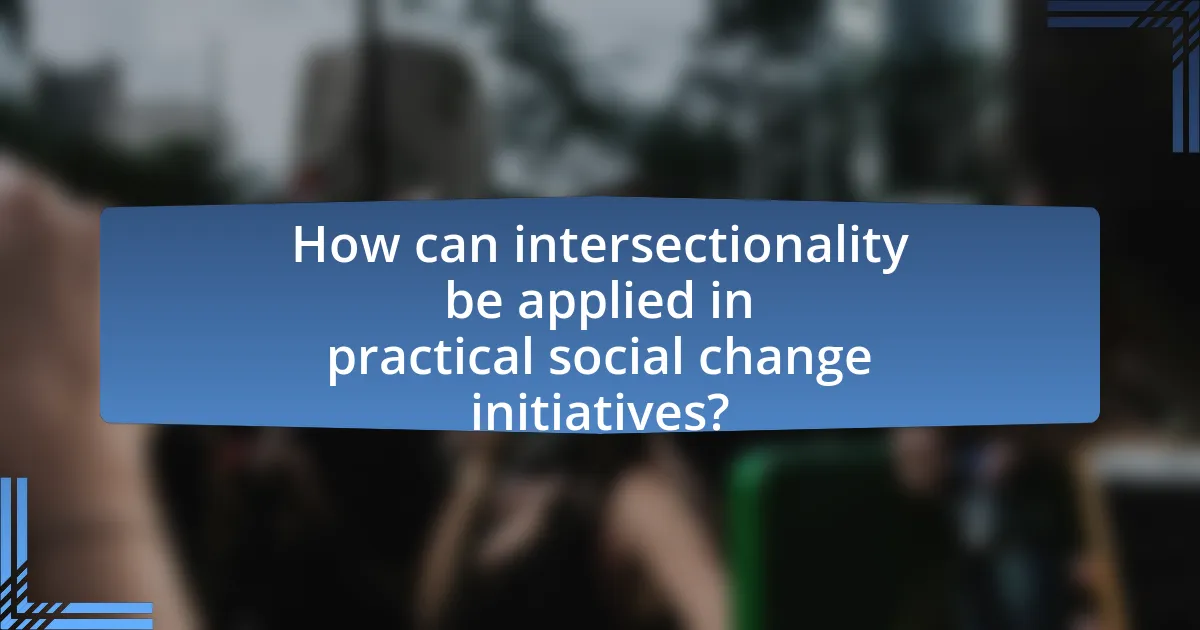
How can intersectionality be applied in practical social change initiatives?
Intersectionality can be applied in practical social change initiatives by ensuring that policies and programs address the overlapping identities and experiences of marginalized groups. For instance, initiatives that focus on economic empowerment must consider how race, gender, and class intersect to affect access to resources. Research by Crenshaw (1989) highlights that failing to account for these intersections can lead to ineffective solutions that do not fully address the needs of those most impacted. By incorporating intersectional analysis, organizations can create targeted interventions that are more inclusive and effective, ultimately leading to more equitable outcomes in social change efforts.
What are some successful examples of intersectional approaches?
Successful examples of intersectional approaches include the Black Lives Matter movement and the Women’s March. The Black Lives Matter movement effectively addresses the intersections of race, gender, and class by advocating for the rights of Black individuals, particularly women and LGBTQ+ people, highlighting systemic injustices faced by these groups. The Women’s March, which began in 2017, emphasizes the importance of inclusivity by bringing together diverse voices advocating for women’s rights, reproductive rights, and racial justice, showcasing the interconnectedness of various social issues. Both movements have mobilized large numbers of people and influenced policy discussions, demonstrating the power of intersectionality in social change.
How did these initiatives incorporate diverse voices?
These initiatives incorporated diverse voices by actively engaging underrepresented communities in the decision-making processes and ensuring their perspectives were reflected in the narratives. For example, initiatives often included community forums, focus groups, and collaborative workshops that allowed individuals from various backgrounds to share their experiences and insights. This approach not only amplified marginalized voices but also enriched the overall discourse, leading to more inclusive and representative outcomes in social change efforts.
What lessons can be learned from these examples?
The lessons learned from examples in exploring intersectionality highlight the importance of recognizing and valuing diverse perspectives in social change narratives. These examples demonstrate that inclusive approaches lead to more effective advocacy and policy-making, as they address the multifaceted nature of social issues. Research shows that movements incorporating intersectional frameworks, such as the Black Lives Matter movement, have achieved greater visibility and impact by amplifying voices from various marginalized communities. This underscores the necessity of collaboration across different identities to foster comprehensive solutions to systemic inequalities.
What best practices should be followed for inclusive social change?
Best practices for inclusive social change include actively engaging diverse communities, ensuring representation in decision-making processes, and fostering collaboration among various stakeholders. Engaging diverse communities allows for a broader understanding of the issues faced by different groups, which is essential for creating effective solutions. Representation in decision-making ensures that the voices of marginalized groups are heard and considered, leading to more equitable outcomes. Collaboration among stakeholders, including non-profits, government, and community organizations, enhances resource sharing and strengthens the impact of initiatives. Research indicates that inclusive practices lead to more sustainable social change, as seen in the success of initiatives like the Global Goals for Sustainable Development, which emphasize inclusivity and participation from all sectors of society.
How can organizations ensure they are listening to diverse voices?
Organizations can ensure they are listening to diverse voices by implementing structured feedback mechanisms that actively solicit input from underrepresented groups. This can include conducting surveys, focus groups, and community forums specifically designed to engage diverse populations. Research shows that organizations that prioritize inclusive practices, such as those outlined in the McKinsey report on diversity, see improved performance and innovation. By analyzing data on employee demographics and engagement, organizations can identify gaps in representation and tailor their outreach efforts accordingly.
What frameworks can guide intersectional social change efforts?
Frameworks that can guide intersectional social change efforts include the Intersectionality Framework, the Social Justice Framework, and the Anti-Oppression Framework. The Intersectionality Framework, developed by Kimberlé Crenshaw, emphasizes the interconnected nature of social categorizations such as race, class, and gender, which create overlapping systems of discrimination or disadvantage. The Social Justice Framework focuses on equitable distribution of resources and opportunities, advocating for marginalized voices in policy-making. The Anti-Oppression Framework addresses systemic inequalities and promotes collective action against various forms of oppression. These frameworks are supported by empirical studies that demonstrate the effectiveness of intersectional approaches in addressing complex social issues, such as the 2019 report by the Institute for Women’s Policy Research, which highlights the need for inclusive policies that consider multiple identities.
